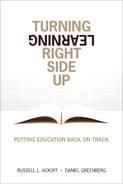Book Description
In the age of the Internet, we educate people much as we did during the Industrial Revolution. We educate them for a world that no longer exists, instilling values antithetical to those of a free, 21st century democracy. Worst of all, too many schools extinguish the very creativity and joy they ought to nourish.
In Turning Learning Right Side Up, legendary systems scientist Dr. Russell Ackoff and “in-the-trenches” education innovator Daniel Greenberg offer a radically new path forward. In the year’s most provocative conversation, they take on the very deepest questions about education: What should be its true purpose? Do classrooms make sense anymore? What should individuals contribute to their own education? Are yesterday’s distinctions between subjects--and between the arts and sciences--still meaningful? What would the ideal lifelong education look like--at K-12, in universities, in the workplace, and beyond?
Ackoff and Greenberg each have experience making radical change work--successfully. Here, they combine deep idealism with a relentless focus on the real world--and arrive at solutions that are profoundly sensible and powerfully compelling.
Why today’s educational system fails--and why superficial reforms won’t help
The questions politicians won’t ask--and the answers they don’t want to hear
How do people learn--and why do they choose to learn?
Creating schools that reflect what we know about learning
In a 21st century democracy, what values must we nurture?
...and why aren’t we nurturing them?
How can tomorrow’s “ideal schools” be operated and funded?
A plan that cuts through political gridlock and can actually work
Beyond schools: building a society of passionate lifelong learners
Learning from childhood to college to workplace through retirement
Table of Contents
- Title Page
- Copyright Page
- Contents
- About the Authors
- Preface: Why, and How, This Book Was Written
- Introduction: What Education Is About
- Part 1. Where Today’s Educational System Fails
- Part 2. Factors That Contribute to Education
- Part 3. Envisioning Ideal Lifelong Education
- Part 4. Excursus: Funding Ideal Schools
- Postscript
- Endnotes
- Index
